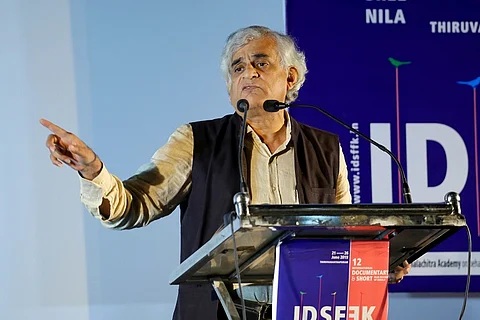

How many of you knew that the National Crime Records Bureau (NCRB) had been shut down for a few months, beginning in August 2017, when it was merged with the Bureau of Police Research and Development (BPRD)? P Sainath, a veteran journalist who has been working in rural areas of India for decades, asks an audience at the Sree Theatre in Thiruvananthapuram. His talk happens in between the screening of Mathieu Roy’s The Dispossessed, a documentary on the hungry farming class, at the International Documentary and Short Film Festival of Kerala. Sainath, who appears in the documentary, commenting on the agrarian crisis in India, has come in person to the festival, to tell filmmakers and journalists there are so many stories they could tell about this crisis.
“A major department – the NCRB – shut down quietly and 10 months later, it was reopened quietly by the Government of India. And after reopening, they are not allowed to publish the data of farmer suicides,” Sainath talks of one story that the media had not been in a hurry to reveal.
From 1995 to 2015, there have been more than 3,00,000 farmer suicides, reported officially. In 2014, the year the NDA government came to power, the numbers had become so embarrassingly huge, says Sainath, that they changed the methodology of collecting data. They put a chunk of the farmer suicides under the column ‘Others’. That way, the number under farmer suicides fell by a large percentage that year, but then, the number under the ‘Others’ column went up by 128 per cent. “In Karnataka, the data showed that the farmer suicides reduced by 60 per cent but under the ‘Others’ column, there was an increase of 245 per cent.”
But the next year, in 2016, the merge with the BPRD happened. However, along with the farmer suicide data, they also lost a lot of other crime data. Ten months later, in 2018, when the two organisations were separated again, the NCRB was told not to publish the farmer suicide data anymore. Meena Menon, journalist and writer, had filed an RTI application, asking for this data (of three years from 2016 to 2018) and received a response that the data for 2016 is under finalisation.
Don’t believe the newspapers that publish imagined numbers from these years because that number comes from the revenue department, Sainath says. “These farmers take their own lives because they are compelled to, not because they want to,” he says. It shows the extent of the loss of humanity when people make arguments that the suicides have nothing to do with the crisis or economic factors, that it is because of acute depression.
“There are two ways to go about this – one, finding out what are the causes or drivers of depression, and two, medicalise the depression. Fortunately, the Indian Association of Clinical Psychiatry and the Indian Association of Psychology have both opted for the first one – finding out what causes depression.”
Those who make the depression argument do not seem to realise that that is the cause of every suicide, no one makes a ‘happy’ suicide. Neither do they wonder why depression appears to affect only the farmers in such a large number, more than any other profession. A journalist had suggested alcoholism to be the reason driving farmer suicides, Sainath recalls. If that were the case, there would be no journalists left, he had answered then.
Sainath also pointed out how suicides of women farmers are seldom considered in this number “because women cannot be farmers, right?” he mocks those who refuse to accept that more than 60 per cent of the farming work is done by women. And after going through all this, when the farmers ask for loan waiver, there is a problem.
“In 1998-99, no farmer had asked for a waiver. It is in 2008-09 that they asked,” Sainath reminds you. The credit system that worked for the farmers had dismantled and was diverted towards corporates, he says. It is true what the politicians claim, that agricultural credit had doubled and tripled, but it just didn’t go to the agriculturalists, Sainath says. He mentions NABARD (National Bank for Agriculture and Rural Development) here, and the loans in amounts of crores of rupees that it has allocated, the amounts clearly indicating the money didn’t go to small farmers.
But there is hope – which you can find between the fake optimism (‘poverty will be gone in six months’) and cynical pessimism. He found it in March 2018 when 40,000 farmers marched from Nashik to Mumbai and on a night they reached the city, exhausted, burnt out and with their feet bleeding, they walked even more, only to avoid trouble for the many children who’d be writing their board exams the next morning. Among those people, he found the hope of humanity; and among the many who went with different kinds of help to the farmers – the doctors wanting to attend to their medical needs, the businessmen who dropped sandals and water satchels anonymously, the lawyers who wanted to file a PIL against the Maharashtra government, the teachers and students and so many others. In Kerala, too, he found hope in the resilient spirit of the women of Kudumbashree, after the floods that had smashed everything for them.